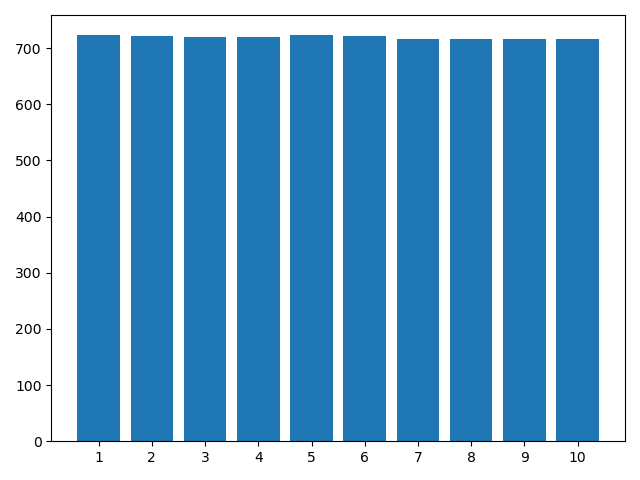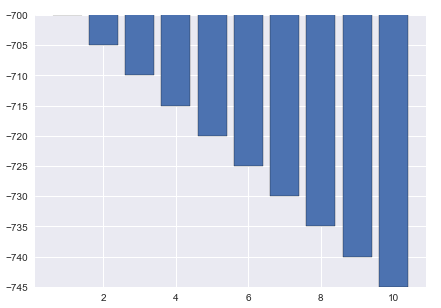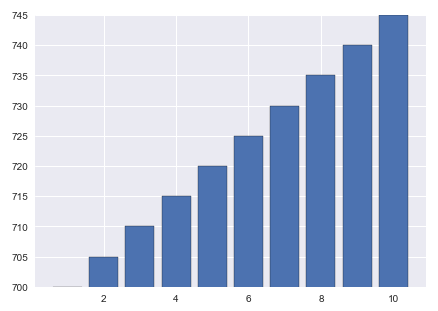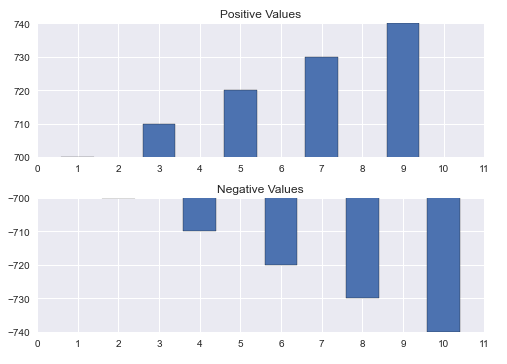如何自动标尺y轴的条形图在材料库?
如何自动标尺y轴的条形图在材料库?
提问于 2020-08-21 14:21:53

我需要用matplotlib自动缩放条形图上的y轴,以显示值的微小差异。它需要自动标度而不是有固定限制的原因是,值将根据用户输入的内容而改变。我试过yscale log,但这对负值不起作用。我尝试过symlog,但是图表保持不变。这是我目前的代码:
x = [1, 2, 3, 4, 5, 6, 7, 8, 9, 10]
y = range(700, 710, 1)
fig, ax = plt.subplots()
ax.bar(x, y)
plt.show()回答 1
Stack Overflow用户
回答已采纳
发布于 2020-08-21 15:15:58
- 绘图是自动缩放提供给API的全部数据的。条形图的
- (显示条形图值差异的最佳选项)可能是为竖直条设置
ylim或为水平条设置xlim。
。
负数据
import matplotlib.pyplot as plt
x = [1, 2, 3, 4, 5, 6, 7, 8, 9, 10]
y = range(-700, -750, -5)
fig, ax = plt.subplots(figsize=(7, 5))
ax.bar(x, y)
plt.ylim(min(y), max(y))

正数据
x = [1, 2, 3, 4, 5, 6, 7, 8, 9, 10]
y = range(700, 750, 5)
fig, ax = plt.subplots(figsize=(7, 5))
ax.bar(x, y)
plt.ylim(min(y), max(y))

混合数据
如果数据具有广泛的正值和负值,那么
- 可能不是一个好的选择,正如您已经指出的,
symlog无助于解决这个问题。最佳选择可能是绘制正负数据separately.
。
创建掩码的
- 不适用于列表,因此将列表转换为numpy数组。
import numpy as np
x = [1, 2, 3, 4, 5, 6, 7, 8, 9, 10]
y = [700, -700, 710, -710, 720, -720, 730, -730, 740, -740]
x = np.array(x)
y = np.array(y)
mask = y >= 0 # positive mask
pos_y = y[mask] # get the positive values
neg_y = y[~mask] # get the negative values; ~ is not
fig, (ax1, ax2) = plt.subplots(2, 1, figsize=(7, 5))
ax1.bar(x[mask], pos_y) # also mask x to plot the bar at the correct x-tick
ax1.set_title('Positive Values')
ax1.set_ylim(min(pos_y), max(pos_y))
ax1.set_xticks(range(0, 12)) # buffer the number of x-ticks, so the x-ticks of the two plots align.
ax2.bar(x[~mask], neg_y)
ax2.set_title('Negative Values')
ax2.set_ylim(min(neg_y), max(neg_y))
ax2.set_xticks(range(0, 12))
plt.tight_layout() # better spacing between the two plots

页面原文内容由Stack Overflow提供。腾讯云小微IT领域专用引擎提供翻译支持
原文链接:
https://stackoverflow.com/questions/63530746
复制相关文章
相似问题
